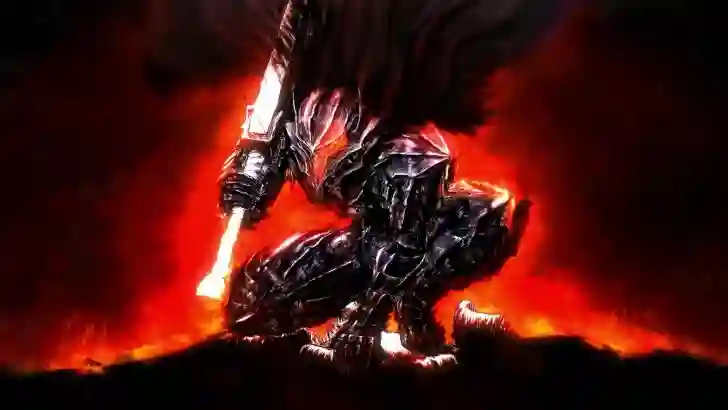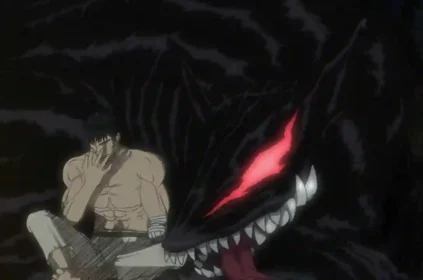Berserk, the magnum opus of Kentaro Miura, stands as a dark fantasy epic known for its unflinching portrayal of violence. In the grim and treacherous world of Midland, where demons and apostles lurk, Miura’s artistry elevates violence beyond mere brutality, transforming it into a visceral and cinematic experience. In this exploration, we delve into the dark beauty of Berserk’s depiction of violence, examining how it serves as both a narrative tool and an artistic expression that transcends traditional boundaries.
Visual Poetry in Brutality:
Berserk’s depiction of violence is not merely graphic; it is a form of visual poetry that unfolds with meticulous detail. Miura’s illustrations, characterized by their intricate linework and evocative compositions, elevate violent scenes to a level of aesthetic intensity. The balletic choreography of battles, the visceral impact of sword strikes, and the haunting beauty of demonic entities create a visual tapestry that captures the essence of Berserk’s dark aesthetic.
Violence, in the hands of Miura, becomes a narrative language—an expressive tool that communicates the harsh realities of Midland and the emotional struggles of its characters. The dark beauty lies not in the brutality itself, but in the nuanced storytelling that accompanies each blood-soaked panel.
Characterizing Desperation and Resilience:
Berserk’s violence is not gratuitous; it serves a profound narrative purpose. The series follows Guts, a lone mercenary marked by the Brand of Sacrifice, as he battles both human and supernatural adversaries. The violence he endures and inflicts becomes a physical manifestation of his desperation and resilience in a world that seems intent on breaking him.
Guts’ battles, often fought against overwhelming odds, showcase the dark beauty of his indomitable will. Each swing of the Dragonslayer, each wound he bears, becomes a testament to his refusal to succumb to the darkness that envelops him. The violence, while brutal, becomes a cinematic portrayal of Guts’ journey—a visual odyssey through the shadows of his own existence.
The Ballet of Blades:
Miura’s portrayal of swordplay in Berserk is akin to a ballet of blades—a dance of death that unfolds with a fluidity and grace that belies its brutality. Whether it’s Guts’ relentless assault on apostles or the duels between skilled warriors, the choreography of violence becomes a visual spectacle that transcends the typical boundaries of manga storytelling.
The interplay of light and shadow, the dynamic angles of sword strikes, and the kinetic energy captured in each frame contribute to the cinematic beauty of Berserk’s violent sequences. Miura’s ability to transform combat into a visual symphony allows readers to immerse themselves in the intensity of each battle, creating an experience that lingers long after the pages are turned.
The Supernatural Horror of Apostles:
Berserk’s violence extends beyond the human realm into the supernatural. Apostles, demonic entities born from the God Hand, bring a grotesque beauty to the series’ depictions of violence. The transformation sequences, where humans morph into nightmarish creatures, are a testament to Miura’s ability to blend horror and aesthetics seamlessly.
The dark beauty lies in the juxtaposition of the monstrous and the macabre—a visual spectacle that evokes both awe and terror. The apostles, with their nightmarish designs and the grotesque violence they unleash, become an integral part of Berserk’s exploration of the supernatural and the boundaries between humanity and monstrosity.
Aestheticizing the Abyss:
Berserk’s violence does not shy away from the abyss; instead, it embraces it as a canvas for artistic expression. Scenes such as the Eclipse, where betrayal and demonic forces converge in a cataclysmic event, exemplify Miura’s ability to aestheticize the darkest corners of the narrative. The grotesque beauty of the God Hand and the visceral horror of the Eclipse become visual spectacles that haunt the reader’s imagination.
By infusing violence with an aesthetic sensibility, Miura invites readers to confront the abyss with a gaze that transcends mere shock. The dark beauty of Berserk’s violence lies in its ability to elicit emotions beyond repulsion—evoking a complex mix of awe, dread, and introspection.
Conclusion:
Berserk’s dark beauty is not confined to its narrative themes or character arcs; it extends into the visceral and cinematic portrayal of violence. Kentaro Miura’s artistry transforms brutality into a visual language that transcends the limitations of traditional storytelling. The balletic swordplay, the supernatural horrors, and the aestheticization of the abyss contribute to Berserk’s unique identity as a dark fantasy epic that embraces the beauty within the shadows.
In the dark and treacherous world of Midland, where violence is an inextricable part of the narrative fabric, the dark beauty of Berserk’s depictions becomes a testament to the series’ ability to evoke emotions and captivate readers through its unparalleled fusion of narrative depth and artistic brilliance. As readers traverse the blood-soaked landscapes of Berserk, they are immersed in a cinematic exploration of darkness—a visual odyssey that lingers in the mind, challenging preconceptions and expanding the boundaries of storytelling in the realm of manga.











